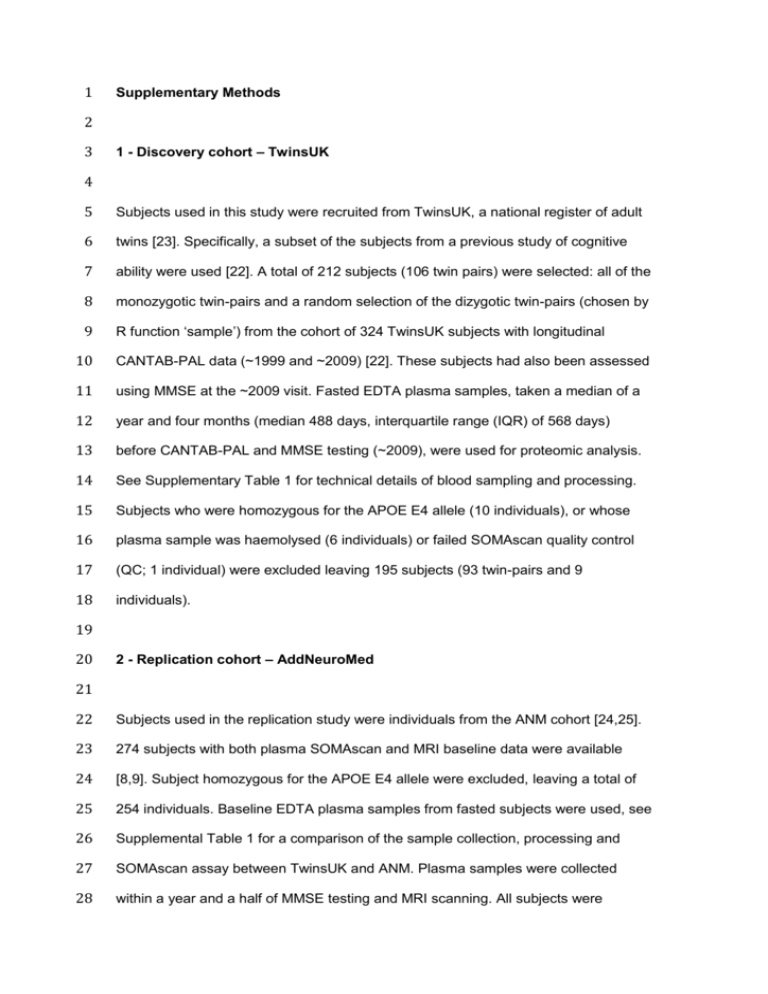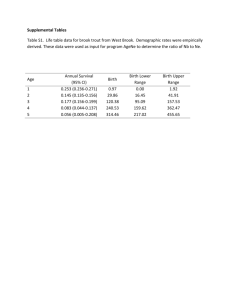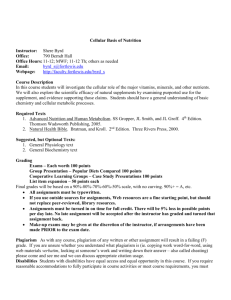Supplementary Information (doc 116K)
advertisement

1 Supplementary Methods 2 3 1 - Discovery cohort – TwinsUK 4 5 Subjects used in this study were recruited from TwinsUK, a national register of adult 6 twins [23]. Specifically, a subset of the subjects from a previous study of cognitive 7 ability were used [22]. A total of 212 subjects (106 twin pairs) were selected: all of the 8 monozygotic twin-pairs and a random selection of the dizygotic twin-pairs (chosen by 9 R function ‘sample’) from the cohort of 324 TwinsUK subjects with longitudinal 10 CANTAB-PAL data (~1999 and ~2009) [22]. These subjects had also been assessed 11 using MMSE at the ~2009 visit. Fasted EDTA plasma samples, taken a median of a 12 year and four months (median 488 days, interquartile range (IQR) of 568 days) 13 before CANTAB-PAL and MMSE testing (~2009), were used for proteomic analysis. 14 See Supplementary Table 1 for technical details of blood sampling and processing. 15 Subjects who were homozygous for the APOE E4 allele (10 individuals), or whose 16 plasma sample was haemolysed (6 individuals) or failed SOMAscan quality control 17 (QC; 1 individual) were excluded leaving 195 subjects (93 twin-pairs and 9 18 individuals). 19 20 2 - Replication cohort – AddNeuroMed 21 22 Subjects used in the replication study were individuals from the ANM cohort [24,25]. 23 274 subjects with both plasma SOMAscan and MRI baseline data were available 24 [8,9]. Subject homozygous for the APOE E4 allele were excluded, leaving a total of 25 254 individuals. Baseline EDTA plasma samples from fasted subjects were used, see 26 Supplemental Table 1 for a comparison of the sample collection, processing and 27 SOMAscan assay between TwinsUK and ANM. Plasma samples were collected 28 within a year and a half of MMSE testing and MRI scanning. All subjects were 29 assessed with a standardized assessment protocol including an informant interview 30 for diagnosis and cognitive assessment such as the MMSE, which has been 31 described previously [24,25]. Subjects were diagnosed as either asymptomatic 32 (control, N = 91), Mild Cognitive Impairment (MCI, N = 81) or AD (N = 82) based on 33 National Institute of Neurological and Communicative Disorders and Stroke and the 34 Alzheimer’s Disease and Related Disorders Association (NINCDS- ADRDA) criteria. 35 36 3 - Proteomics 37 38 SOMAscan methods and data for TwinsUK and ANM have been described 39 previously [18], but are described again briefly here. Proteins were measured using a 40 SOMAmer-based capture array called ‘SOMAscan’ (SomaLogic, Inc, Boulder, 41 Colorado). For more details on the assay see Gold et al [11] and the SomaLogic Inc 42 website (http://www.somalogic.com/Products-Services/SOMAscan/FAQs.aspx). 43 44 A single assay was used per plasma sample, i.e. no technical replicates were 45 performed. TwinsUK proteomic data was collected using SOMAscan version 3 on 65 46 μl of plasma, measuring 1,129 proteins, whereas ANM+ARUK+DCR proteomic data 47 was collected using SOMAscan version 2 on 8 μl of plasma, measuring 1,001 48 proteins. All except 21 of the proteins measured by SOMAscan v2 are also measured 49 by SOMAscan v3. TwinsUK proteomics data are publicly available upon request on 50 the department website (http://www.twinsuk.ac.uk/data-access/accessmanagement/). 51 We aim to make the ANM+ARUK+DCR data available to the public as soon as 52 possible. In the short term the authors can be contacted and collaborations 53 established under an agreement shared with SomaLogic. 54 55 SomaLogic’s standard QC and normalization processes were applied [18]. Data from 56 one sample from the TwinsUK cohort failed SomaLogic’s QC procedures and so was 57 excluded. Six additional TwinsUK samples (two from subjects who had undergone 58 MRI scans) appeared to be haemolysed, and so were excluded. No Principal 59 Component Analysis (PCA) outliers were identified for the TwinsUK SOMAscan data, 60 whereas 7 PCA outliers from the ANM+ARUK+DCR SOMAscan data were identified 61 and excluded. All proteomics data was transformed using the natural logarithm and 62 transformed to zero mean and unit standard deviation SD. Additionally, protein 63 values >2.5 SD from the mean were excluded as outliers. This cutoff was chosen as 64 a lower cutoff produced low p-values for some proteins which appeared to be driven 65 by outliers. 66 67 4 – TwinsUK Magnetic Resonance Imaging 68 69 TwinsUK MRI scans were performed approximately two years after plasma sampling 70 and MMSE testing (median 805 days, IQR 151 days). Volumes of the hippocampi 71 and the combined Brodman’s areas 28 and 34 (equivalent to the entorhinal cortex) in 72 the TwinsUK cohort were obtained from 38 subjects using the Diffeomorphic 73 Anatomical Registration through Exponentiated Lie Algebra (DARTEL) technique 74 [26]. This method produces a template based on this population of older female 75 brains leading to improved registration. Structural processing was performed using 76 Statistical Parametric Mapping (SPM8) software 77 (http://www.fil.ion.ucl.ac.uk/spm/software/spm8). The structural magnetic resonance 78 images were converted to axial slices and origins of all images reset to the anterior 79 commissure, prior to segmentation using the standard unified segmentation model in 80 SPM8 [27]. Then, Grey Matter (GM) population templates were generated from the 81 entire image dataset using the DARTEL technique [26]. After an initial affine 82 registration of the GM DARTEL templates to the tissue probability maps in Montreal 83 Neurological Institute (MNI) space (http://www.mni.mcgill.ca/), non-linear warping of 84 GM images was performed to the DARTEL GM template in MNI space with a 1.5mm 85 cubic resolution. The GM volume (GMV) at each voxel was obtained through 86 modulation. Finally, the GMV images were smoothed with Gaussian kernel with a 87 Full-Width at Half-Maximum of 8mm. After spatial pre-processing, GMV for the 88 regions of interest were extracted from the smoothed, modulated and normalized 89 images using MarsBar software [28]. 90 91 5 - APOE genotyping 92 93 DNA was extracted from whole blood samples from TwinsUK samples using Nucleon 94 BACC3 Genomic DNA Extraction Kits (GE Healthcare, Buckinghamshire). DNA was 95 extracted from blood leukocytes from ANM samples by a standard phenol-chloroform 96 extraction. The SNPs rs429358 and rs7412 were determined by allelic discrimination 97 assays based on fluorogenic 59 nuclease activity, and the alleles inferred. APOE 98 data for subjects with ambiguous genotypes were treated as missing. TaqMan SNP 99 genotyping assays were performed on an ABI Prism 7900HT and analyzed using 100 SDS software, according to the manufacturer’s instructions (Applied Biosystems, 101 Warrington, UK). 102 103 6 - Statistical analysis 104 105 All statistical analyses were performed in R 3.1.0, except for the transformation and 106 10-year change calculations for cognitive scores. All double APOE e4 carriers were 107 excluded from analyses, as too few were present in the discovery cohort to make 108 inclusion as a co-variate viable. Regressions in the discovery cohort were performed 109 using Generalised Estimation Equations (GEE), allowing twin dependencies to be 110 accounted for as clusters with exchangeable correlation structures [34,35]. GEE 111 analysis was performed using the ‘geepack’ package. For MMSE, due to skewness, 112 GEE was also performed against dichotomised MMSE scores (29-30 vs 23-28). 113 Linear regressions were performed using the ‘lm’ command. Subject age, gender, 114 and recruitment centre were used as co-variates in all regressions, except in 115 TwinsUK were a single centre was used, and the female only subcohort analyses 116 where gender was not relevant. Skewness was calculated using the ‘e1071’ 117 package. The Benjamini-Hochberg (i.e. False Discovery Rate) multiple testing 118 correction was used to generate Q-values using ‘p.adjust’, with thresholds of Q < 119 0.05 used to indicate association and Q < 0.1 to indicate suggestive association. All 120 SOMAscan analyses were performed using all proteins, except replication and twin 121 difference analyses, which focused on candidates to increase statistical power. 122 123 Analysis of association between a protein level and 10-year change in CANTAB-PAL 124 in the MZ-twin difference context was performed by calculating twin differences in 125 both, and performing a linear regression between the two differences, covarying for 126 twin-pair age. 127 128 Twin modeling was performed using Structural Equation Modelling in OpenMX [36] in 129 R to estimate the proportion of variance explained by additive genetics (A), shared 130 environment (C) and non-shared environment (E). This was performed on the 131 SOMAscan data, both untransformed, and transformed using the Van der Waerden 132 transformation (script provided by Maciej Trzaskowski). 133 134 STATA 11 was used for square root transformation of CANTAB-PAL total errors, and 135 to calculate the 10-year change in CANTAB-PAL total errors as described in Steves 136 et al [22]. It was also used to calculate 10-year change as a residual of a linear 137 model, co-varying for baseline score [22].









